Pipe bending machines are typically human powered, pneumatic powered, hydraulic assisted, or electric servo motor. In the pipe bending operation the tube may be supported internally or externally to preserve the cross section of the pipe. In operations where there is flexibility in the shape of the pipe, the pipe does not need to be supported, however there will be some deformation in the both the cross section of the overall pipe and the wall thickness in different areas of the bend.
Tube bending as a process starts with loading a tube into a pipe bender and clamping it into place between two dies, the clamping block and the forming die. The tube is also loosely held by two other dies, the wiper die and the pressure die. After that has been completed the fitter will start the bender, while the tube is pulled around the forming die creating an elbow, U-bend, 2-D or 3-D bent tubes. A three dimensional tube is a tube with each opening on different planes. A two dimensional tube is a tube with each opening on the same plane. The picture below shows a typical manual pipe benders with the main parts named.
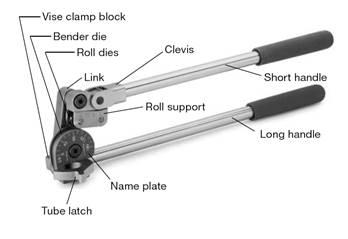
Manual pipe benders for bending thin wall tube
Pipe bending techniques are varied and offer different advantages and disadvantages depending on the function of the bend and the type of material being bent. Some use mechanical force and some use heat treatment, the most common are as follows:
Press bending is the simplest and cheapest method of bending cold pipe and tube. The pipe or tube is restrained at two eternal points and a ram in the shape of the bend advances on the central axis and deforms the pipe.
The bent pipe or tube is prone to deformation on both the inside and outside curvature. The pipe or tube is often deformed into an oval shape depending on the wall thickness of the material. This process is used where a consistent cross section of the pipe is not required.
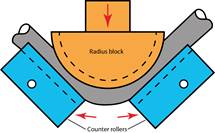
This type of bending is suitable for bending electrical conduit and similar light gauge product.
Press or Ram bending
This is the most commonly used style of bender for bending pipe and tube where maintaining a good finish and constant diameter is important.
Rotary draw benders (RDB) are precise in that they bend using tooling or "die sets" which have a constant center line radius (CLR). The die set consists of two parts: The bend die creates the shape to which the material will be bent. The pressure die does the work of pushing the straight material into the bend die while traveling the length of the bend. Often a positioning index table (IDX) is attached to the bender allowing the operator to reproduce complex bends which can have multiple bends and differing planes.
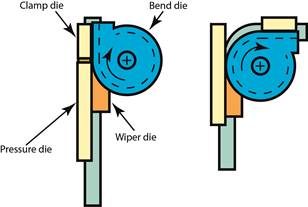
Rotary draw benders are the most popular machines for use in bending tube, pipe and solids for applications like: handrails, frames, instrument tubing and much more. Rotary draw benders create aesthetically pleasing bends when the right tooling is matched to the application.
Rotary draw bending
Mandrel benders are similar to the rotary draw bender but use an additional wiper die on the outside of the tube and a mandrel which is inserted into the tube which remains inside the tube during the bend process. This internal mandrel helps to support the shape of the wall when bending. Typically a mandrel bender is needed when bending thin wall tubing to a radius much tighter than the material can bend without collapsing or distorting.
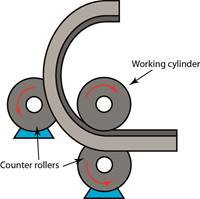
3-roll bending is also used for producing work pieces with large bending radii. The method is similar to the ram bending method, but the working cylinder and the two stationary counter-rollers rotate, thus forming the bend. Normally there are 2 fixed rollers and one moving roller and the work piece is passed forward and backward through the rollers while gradually moving the working roller closer to the counter rollers which changes the bend radius in the pipe. This method of bending causes very little deformation in the cross section of the pipe and is suited to producing coils of pipe as well as long sweeping bends like those used in powder transfer systems where large radii bends are required.
3 Roll Bending
These are strong but flexible springs inserted into a pipe to support the pipe walls during manual bending. They have diameters only slightly less than the internal diameter of the pipe to be bent. They are typically only used for bending 15-to-25 mm soft copper pipe (used in household plumbing). The spring is pushed into the pipe until its center is roughly where the bend is to be. A length of flexible wire can be attached to the end of the spring to facilitate its positioning and removal. The pipe is generally held against the flexed knee, and the ends of the pipe are pulled up to create the bend. To make it easier to retrieve the spring from the pipe, it is a good idea to bend the pipe slightly more than required, and then slacken it off a little. They are less cumbersome than rotary benders, but are not suitable for bending short lengths of piping when it is difficult to get the requires leverage on the pipe ends. Bending springs for smaller diameter pipes (10 mm copper pipe) slide over the pipe instead of inside.
In the case of heat induction, a coil is placed around the pipe. The coil heats a section of the pipe to a temperature between 430 and 1,200 °C. The temperature depends on the material. The pipe passes through the coil at a gradual rate while a bending force is mechanically applied to the pipe. The pipe is then quenched with either air or water spray. The products thus obtained are generally of high quality, but cost significantly more to produce.
In the sand packing process the pipe is filled with fine sand and the ends are capped. The pipe is then heated in a furnace to 870 C or higher. The pipe is then placed on a slab with pins set in it. The pipe is then bent around the pins using a winch, crane, or some other mechanical force. The sand in the pipe minimizes distortion in the pipe cross section. It is an old process but one that hasn’t really been improved on for its flexibility when it comes to unique applications, and so is still in common use.
When bending a pipe to any radius it should be remembered that you are constructing part of a circle.
The parts of a circle relevant to a pipe bending are:
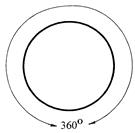
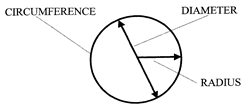
Parts of a Circle 360°in a Circle
Therefore, there are four 90° segments in every circle.
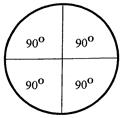
Four 90° Segments in a Circle
A 90 bend involves bending a pipe through ¼ of a circle.
In the following examples the following abbreviations will be used:
C = Circumference
R = Radius
D = Diameter
π = 3.142
Calculate the total length of pipe to be heated to bend a pipe through 90° to a radius of 75mm.
To carry out this calculation we must find the length of the circumference and divide it by 4:
If R = 75mm
Then D = 150mm
C = π D
Therefore: C = 3.142 X 150mm
C = 471mm
Length of pipe to be heated = 471 ÷ 4 = 117.75
Which can be written as 118mm.
Calculate the total length of pipe to be heated to bend a pipe through 180° to a radius of 150mm.
To carry out this calculation we must find the length of the circumference and divide it by 2:
If R = 150
Then D = 300mm
C = π D
Therefore: C = 3.142 X 300mm
C = 943mm
Length of pipe to be heated = 943 ÷ 2 = 471.5
Which can be written as 472mm.
Calculate the total length of pipe required to bend a pipe through 90° to a radius of 50mm.
To carry out this calculation we must find the length of the circumference and divide it by 4:
If R = 50
Then D = 100mm
C = π D
Therefore: C = 3.142 X 100mm
C = 314.2mm
Length of pipe required = 314 ÷ 4 =78.5
Which can be written as 79mm.
Depending on the bending method used and the material qualities of the pipe or tube being bent some of the following physical effects can be seen after bending:
The mechanical properties of the materials are also altered during the bending process.
Annealing is the treatment of a metal or alloy to reduce its brittleness and improve its ductility. Annealing is often referred to as the softening of a metal. If a metal becomes work hardened (by bending) it may require softening before work is continued, otherwise it might fracture. Annealing is achieved by the application of heat.
Copper pipes are annealed before spring bending. The pipe is heated to a dull red colour and then allowed to cool or quenched in cold water.
Tempering or hardening, is a process of improving the characteristics of a metal, especially steel. Tempering is carried out by heating the metal to a high temperature and then cooling it, usually by quenching it in oil or water.
Cold chisels, screwdrivers, bending springs and the jaws of stilsons are examples of tools which are tempered.
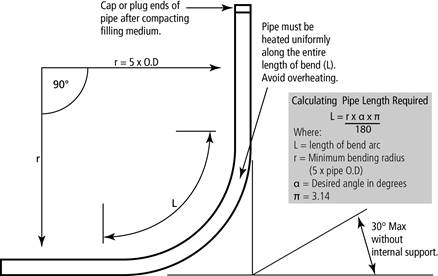
Bending of plastic pipes may be desirable under certain conditions where long-radius bends and unusual configurations are required. It is possible to bend various sizes and wall thicknesses of rigid PVC-U, PVC-C and ABS pipe using heat bending techniques for long-radius sweeps for conduit and flow conditions. Irregular angles and U-bends for thermal compensation, and offsets in congested areas can be successfully achieved.
Guidelines for heat bending of plastic pipes
Successful bending requires that the appropriate amount of heat be applied uniformly to the required length of pipe to be bent. This presents the greatest challenge for field bending, as the heating method used must provide the necessary amount of heat over the required length of pipe in a reasonable amount of time. Several common pipe heating methods used in the field involve the use of hot air ovens, electric box heaters, electric pipe heating blankets, internal electric coiled heating springs and flameless hot gas torches. Temperatures necessary to heat the pipe are dependent on pipe size and the severity of the desired bend radius. In general, PVC pipe should be heated from 100°C to 135°C for the minimum amount of time necessary to achieve uniform softening. Care should be taken to avoid exposing the pipe to bending temperatures for an excessive length of time, as irreparable distortion and deformation will occur. Localized overheating must be avoided. Successful minor bends (< 30°) can be achieved with minimum distortion in the lower temperature range (100°C) without internal support.
Sharp bends (> 30°) require higher temperatures (120°-135°C) as well as internal support. Filling the pipe with fine grain sand or perlite prior to heating provides the internal support necessary to prevent wall distortion/collapse while at the same time provides an excellent medium for uniform heat distribution during the heating process.
It should be noted that most bending procedures will induce stress into the pipe wall which can be retained in the material after the bend radius is formed. The amount of stress induced is dependent on the severity of the bend, the diameter and wall thickness of the pipe bent, and the bending method used. This residual stress will be added to the normal stresses created by internal pressure, installation procedures, and the effects of temperature. Therefore, pipe bending should be limited to applications for use at ambient temperatures or lower where maximum operating pressures are not utilized. The use of a filling medium during the bending process may also cause slight pitting and other interior surface blemishes depending on the method used.
Attempting to form bends in rigid thermoplastic piping at temperatures too low can induce excessive stress into the pipe, thereby jeopardizing its physical performance.
Please follow these safety precautions prior to conducting any heat bending procedures on plastic pipes.

When operating pipe and tube bending equipment the operator should be properly trained and supervised and observe all the general safe working procedures required for bending processes. While this is not meant to be an exhaustive list some specific points to note for pipe or tube bending are as follows:
Always -
The following are generic guidelines for hydraulic pipe and tube bending equipment, as there are many different suppliers of bending equipment it is not possible to provide a specific check list. This information does not replace the manufacturer’s instruction guide, it is meant only to acquaint the operator with some basic functions and safety tips that he/she must be aware of.
Equipment, particularly hydraulic power sources, vary considerably in their control and safety arrangements and therefore it is important to verify that actual equipment used is set-up correctly.
Maintain product labels and nameplates. These carry important safety information.
Source: http://local.ecollege.ie/Content/APPRENTICE/liu/pipefitting/word/M3_U7_Pipe%20Bending.doc
Web site to visit: Source: http://local.ecollege.ie
Author of the text: indicated on the source document of the above text
If you are the author of the text above and you not agree to share your knowledge for teaching, research, scholarship (for fair use as indicated in the United States copyrigh low) please send us an e-mail and we will remove your text quickly. Fair use is a limitation and exception to the exclusive right granted by copyright law to the author of a creative work. In United States copyright law, fair use is a doctrine that permits limited use of copyrighted material without acquiring permission from the rights holders. Examples of fair use include commentary, search engines, criticism, news reporting, research, teaching, library archiving and scholarship. It provides for the legal, unlicensed citation or incorporation of copyrighted material in another author's work under a four-factor balancing test. (source: http://en.wikipedia.org/wiki/Fair_use)
The information of medicine and health contained in the site are of a general nature and purpose which is purely informative and for this reason may not replace in any case, the council of a doctor or a qualified entity legally to the profession.
The texts are the property of their respective authors and we thank them for giving us the opportunity to share for free to students, teachers and users of the Web their texts will used only for illustrative educational and scientific purposes only.
All the information in our site are given for nonprofit educational purposes